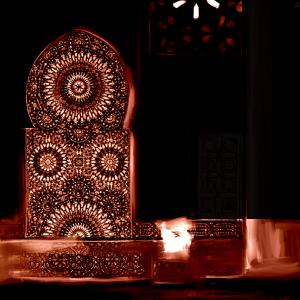Sale on canvas prints! Use code ABCXYZ at checkout for a special discount!

What is a Zellige?
Zellige is mosaic tilework made from individually chiseled geometric tiles set into a plaster base. This form of Islamic art is one of the main characteristics of Moroccan architecture. It consists of geometrically patterned mosaics, used to ornament walls, ceilings, fountains, floors, pools and tables.
Where did Zellige originate from?
The Moorish art of zellige flourished during the Hispano-Moresque period of the Maghreb and the area known as Al-Andalus (modern day Spain) between 711-1492. The technique was highly developed during the Nasrid dynasty and Merinid dynasty who gave it more importance around the 14th century and introduced blue, green and yellow colours. Red was added in the 17th century. The old enamels with the natural colours were used until the beginning of the 20th century and the colours had probably not evolved much since the period of Merinids. The cities of Fes and Meknes in Morocco, remain the centers of this art.
Zellige and Islamic history
Patrons of the art used zellige historically to decorate their homes as a statement of luxury and the sophistication of the inhabitants. Zellige is typically a series of patterns utilizing colourful geometric patterns. This framework of expression arose from the need of Islamic artists to create spatial decorations that avoided depictions of living things, consistent with the teachings of Islamic law.
Evolution of Zellige
As the colour palette of the zellige tiles increased over the centuries, it became possible to multiply the compositions ad infinitum. The most current form of the zellige is a square. Other forms are possible: the octagon combined with a cabochon, a star, a cross, etc. It is then moulded with a thickness of approximately 2 centimetres. There are simple squares of 10 by 10 centimeters or with the corners cut to be combined with a coloured cabochon. To pave an area, bejmat, a paving stone of 15 by 5 centimetres approximately and 2 centimetres thick, can also be used.
Zellige and CATF
CATF has depicted this ancient and rich form of Islamic art in its deluxe paintings. Check out zellige in all its magnificence today at 1-catf.pixels.com